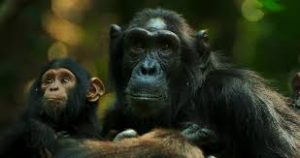 The Columbia City Yoga on-line Moving into Meditation class met this morning. Today’s class focused on bringing a compassionate and non-harming approach to mindfulness practice. We reflected on how fear and stress can actually change our brains and incline us toward aggression. Given the right conditions – including a little help from our friends – we can cultivate peaceful, compassionate mind states. As Rosemerry Wahtola Trommer writes:
The Columbia City Yoga on-line Moving into Meditation class met this morning. Today’s class focused on bringing a compassionate and non-harming approach to mindfulness practice. We reflected on how fear and stress can actually change our brains and incline us toward aggression. Given the right conditions – including a little help from our friends – we can cultivate peaceful, compassionate mind states. As Rosemerry Wahtola Trommer writes:
Every day,
with every small kindness,
with every generous act,
we strengthen [the safety net]. Notice,
even now, how
as the whole world
seems to be falling, it
is there for us as we
walk the day’s tightrope,
how every tie matters.
Today’s practice was informed by the behavioral similarities between chimpanzees and humans. The recent docuseries, Chimp Empire, intimately portrays tender moments of social bonding. It also shows aggressive in-group behavior as members vie for status and violent inter-group clashes over territory. I could see a reflection of human dramas playing out in the world today.
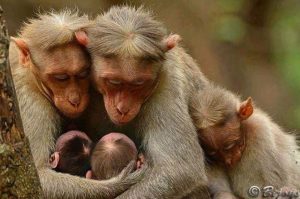 In contemplating these similarities I listened to an informative interview with Prof. Robert Sapolsky entitled Primate and Human Wars. What’s Behind Our Aggression? I learned that the oldest part of chimp and human brains are exactly alike. Our survival programming centers around fear and an imperative to pass on our genes. We humans have the ability to create new meanings by inference and theory of mind. We can imagine and create, plan and remember. In the right social environments we humans can develop to become nonviolent. We can become kinder and more compassionate.
In contemplating these similarities I listened to an informative interview with Prof. Robert Sapolsky entitled Primate and Human Wars. What’s Behind Our Aggression? I learned that the oldest part of chimp and human brains are exactly alike. Our survival programming centers around fear and an imperative to pass on our genes. We humans have the ability to create new meanings by inference and theory of mind. We can imagine and create, plan and remember. In the right social environments we humans can develop to become nonviolent. We can become kinder and more compassionate.
 Some of us can engage in creative acts such as writing a poem like Rosemerry Whatola Trommer’s Safety Net. There is a magical alchemy in which Rosemerry’s creative feeling conjures words that travel to my heart and stir feeling. This human experience is one that I cherish.
Some of us can engage in creative acts such as writing a poem like Rosemerry Whatola Trommer’s Safety Net. There is a magical alchemy in which Rosemerry’s creative feeling conjures words that travel to my heart and stir feeling. This human experience is one that I cherish.
Our time together is so precious. It’s like a sanctuary in a world so full of love, turbulence and suffering. I’ve been watching love, turbulence and suffering in a documentary series called Chimp Empire. The film makers embedded themselves with the Ngogo chimpanzees in Uganda’s Kibale National Park for over a year. I watched tender moments of intimacy between chimps. I also witnessed both inner group struggles and violence between the group and non group bands. What struck me so powerfully was a sense of fear and an imperative for safety. Periods of kindness, playfulness and sharing alternated between times of vigilance, competitiveness and violence. While they appear to be living in the present moment, they have just enough consciousness to torment themselves. They seem so human.
I’ve been thinking about our sameness and what makes us different – especially where aggression is concerned. I learned from Dr. Robert Sapolsky that the neurons, chemicals and circuitry of our brains are exactly the same as those in chimp brains. The oldest part of the brain works the same way when perceiving threat and responding to fear. The amygdala is lightening fast and prone to making mistakes. The more stress and aggression, we experience the larger the amygdala becomes and the more reactive we become.
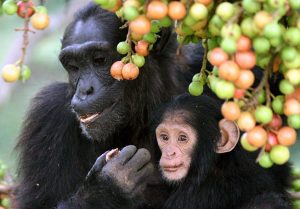 Chimpanzees will organize violence against each other just like we do. But no chimp has ever killed another chimp over ideology or religion or economic systems. We differ in the ways we identify kin and non-kin. Other species can identify kin by smell. A rat can smell a stranger and tell whether it’s a half brother, the first cousin or the 14th cousin. We humans don’t have sensory recognition of relatives. We have to think about it, look for similarities in behavior and habits. Our cognitive ability, the frontal cortex, helps us to reason and also makes us the most aggressive and damaging species on Earth.
Chimpanzees will organize violence against each other just like we do. But no chimp has ever killed another chimp over ideology or religion or economic systems. We differ in the ways we identify kin and non-kin. Other species can identify kin by smell. A rat can smell a stranger and tell whether it’s a half brother, the first cousin or the 14th cousin. We humans don’t have sensory recognition of relatives. We have to think about it, look for similarities in behavior and habits. Our cognitive ability, the frontal cortex, helps us to reason and also makes us the most aggressive and damaging species on Earth.
Culture and biology, genes and evolution all work and interconnect with each other. Our social environment influences our behavior by changing our brains. Those influences start when we are in our mother’s womb. If we are fortunate enough to have mothers who are flourishing, who pick us up when we cry, who nurture us, we have a better chance of growing up to be less violent more compassionate people.
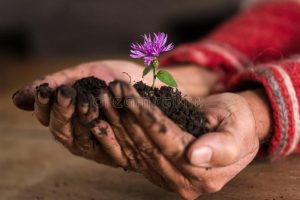 These influences are part of the many, many causes and conditions that enable us to be here today. They enable us to anguish over the pain and suffering happening in the world and also within our own families and communities. We can imagine and witness so much fear, anger and sadness. We can also imagine acts of kindness.
These influences are part of the many, many causes and conditions that enable us to be here today. They enable us to anguish over the pain and suffering happening in the world and also within our own families and communities. We can imagine and witness so much fear, anger and sadness. We can also imagine acts of kindness.
In his On Being conversation with Krista Tippett, Thich Nhat Hanh describes mindfulness as a practical antidote to anger. He said:
. . . violence cannot end violence; that only understanding and compassion can neutralize violence . . . [W]ith the practice of loving speech and compassionate listening we can begin to understand people and help people to [recognize] wrong perceptions . . . at the foundation of their anger, their fear, their violence, their hate. . . . We have to remain human in order to be able to understand and to be compassionate.
 Perhaps remaining human requires that we embrace our wholeness – a wholeness that includes the knowledge that we are often driven and misguided by our fears. It includes faith in our capacity to pause, to do no harm and hold each other in compassion. We might realize how all can be held in kindness as Rosemerry Wahtola Trommer describes in her poem the,
Perhaps remaining human requires that we embrace our wholeness – a wholeness that includes the knowledge that we are often driven and misguided by our fears. It includes faith in our capacity to pause, to do no harm and hold each other in compassion. We might realize how all can be held in kindness as Rosemerry Wahtola Trommer describes in her poem the,
Safety Net
This morning I woke
thinking of all the people I love
and all the people they love
and how big the net
of lovers. It felt so clear,
all those invisible ties
interwoven like silken threads
strong enough to make a mesh
that for thousands of years
has been woven and rewoven
to catch us all.
Sometimes we go on
as if we forget
about it. Believing only
in the fall. But the net
is just as real. Every day,
with every small kindness,
with every generous act,
we strengthen it. Notice,
even now, how
as the whole world
seems to be falling, it
is there for us as we
walk the day’s tightrope,
how every tie matters.
Let us make compassion and non-harming the foundation of our meditation practice. A commitment to non-harming can benefit the world so far beyond our meditation cushion. Perhaps non-harming and mindfulness are one in the same, two essential threads in the tightrope we walk in which every tie matters.
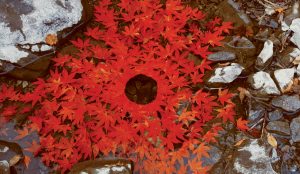 I invite you to bring a commitment to non-harming to today’s practice. See if you can practice with compassion and kindness. There may be impulses toward hostility or anger, criticism or fear around what arises. As you recognize these impulses, can you also see the suffering they bring? Compassion often arises as you are able let them be. Try meeting these mind states with a peaceful non-harming. A peaceful letting be. Let the flames of anger blow themselves out because they are not being fed. Know that you can come back to a peaceful letting be with every breath.
I invite you to bring a commitment to non-harming to today’s practice. See if you can practice with compassion and kindness. There may be impulses toward hostility or anger, criticism or fear around what arises. As you recognize these impulses, can you also see the suffering they bring? Compassion often arises as you are able let them be. Try meeting these mind states with a peaceful non-harming. A peaceful letting be. Let the flames of anger blow themselves out because they are not being fed. Know that you can come back to a peaceful letting be with every breath.
Adjust your posture as you need to feel Earth’s support. Let Earth nourish a posture of kind, confident presence. Take a moment or two to settle into your self, a living, breathing earthling.
Can you gentle your breathing? Allow it the freedom to be as easy or as full as it is. You might explore very gently drawing a bit more or a bit less. Can you find relaxation in the letting the out-breath go? Gradually sense an easeful breathing. Let your awareness lightly touch this easeful breathing. A peaceful letting be.
 Let awareness lightly, non-assertively, touch areas of the body. And then invite these areas to relax. Relax into a peaceful letting be. Across the brow and behind the brow, around the eyes. Inside ears, nose and throat. You might notice this attitude of non-harming as a gentle weightless light. Like the air, it can pervade everything. Touching areas across the upper back, shoulders, arms and hands. Relaxing and letting go. Suffuse the body in non-harming, peace. This breath one of the many in the net of interbeing.
Let awareness lightly, non-assertively, touch areas of the body. And then invite these areas to relax. Relax into a peaceful letting be. Across the brow and behind the brow, around the eyes. Inside ears, nose and throat. You might notice this attitude of non-harming as a gentle weightless light. Like the air, it can pervade everything. Touching areas across the upper back, shoulders, arms and hands. Relaxing and letting go. Suffuse the body in non-harming, peace. This breath one of the many in the net of interbeing.
Notice the gently expanding and releasing around the upper chest and belly. This non-harming awareness is without force. Open to receive and release each breath freely. Feel the freedom of non-harming toward whatever arises. Meet whatever’s aversive with this peaceful letting be.
Gently moving awareness along the length of your spine. Perhaps sensing the sparkly aliveness of nervous tissue as self and world engage one another. Feel the pelvis, hips, legs and feet resting on Earth’s body. Sense the aliveness she offers so freely. Receive the breath given so freely. Given without expectation or force. Given in peace.
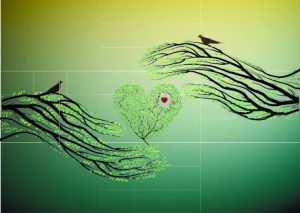 If you find peace, can you find the wisdom of non-harming within? In knowing this inner wisdom can you imagine radiating this wisdom out into the world? Can you send a gentle suffusion of kindness, non-harming and peace? We can remember there is no gesture of kindness that is wasted, no offering of compassion that is useless. May we be generous to every sorrow we see.
If you find peace, can you find the wisdom of non-harming within? In knowing this inner wisdom can you imagine radiating this wisdom out into the world? Can you send a gentle suffusion of kindness, non-harming and peace? We can remember there is no gesture of kindness that is wasted, no offering of compassion that is useless. May we be generous to every sorrow we see.
Every day,
with every small kindness,
with every generous act,
we strengthen it. Notice,
even now, how
as the whole world
seems to be falling, it
is there for us as we
walk the day’s tightrope,
how every tie matters.

